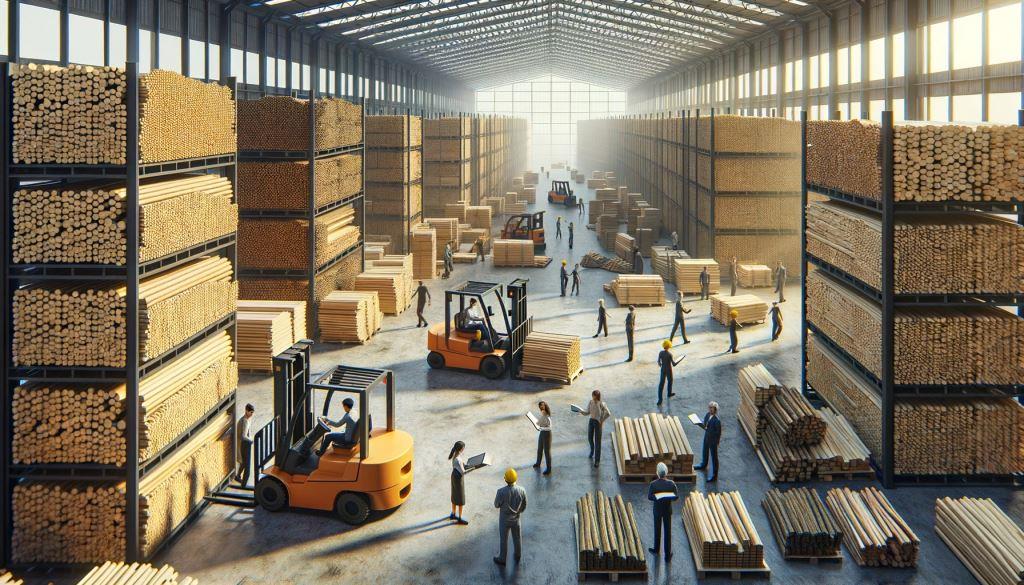Стратегії в B2B-сегменті ринку деревини
Значення деревини в B2B секторі
Деревина завжди відігравала ключову роль у розвитку різних галузей промисловості, і сьогодні її значення у B2B секторі продовжує зростати. Від будівництва та меблевого виробництва до виробництва паперу та енергетики – деревина є фундаментальним ресурсом, який забезпечує стабільність та розвиток бізнесу. У сучасному світі, де важливість сталого використання природних ресурсів набирає обертів, галузь деревообробки та її вплив на B2B ринок вимагає глибшого аналізу та оцінки.

Різновиди деревини для комерційного використання
Різноманітність видів деревини, яка доступна на ринку для комерційного використання, вражає своїм розмаїттям та специфічними характеристиками, що задовольняють різні потреби B2B сектору. Від міцних та довговічних порід, ідеальних для будівництва та виготовлення меблів, до більш м’яких та легких – кожен тип деревини має свої унікальні переваги.
- Тверді породи: дуб, бук, ясен – ці породи відомі своєю міцністю та довговічністю, роблячи їх вибором номер один для виробництва високоякісних меблів, паркету та інших конструкційних елементів.
- М’які породи: сосна, ялина, кедр – ці види деревини часто використовуються у виробництві віконних рам, дверей, а також у пакувальній промисловості через їх невелику вагу та легкість обробки.
- Екзотичні породи: тік, махагон, бамбук – вони приваблюють своєю унікальною текстурою та кольором, що робить їх популярними у виготовленні декоративних елементів та ексклюзивних меблів.
- Перероблена деревина: ДСП, МДФ, фанера – це штучно створені матеріали, які використовуються у бюджетних та масових виробництвах, пропонуючи економічну альтернативу натуральній деревині.
Кожен з цих видів деревини займає своє місце на ринку, задовольняючи специфічні потреби різних секторів B2B ринку.
Як вибрати постачальника деревини для бізнесу
Вибір постачальника деревини є ключовим рішенням для будь-якого бізнесу в B2B секторі, оскільки від цього залежить якість продукції, стабільність поставок та, в кінцевому рахунку, загальний успіх на ринку. Щоб зробити правильний вибір, варто звернути увагу на наступні аспекти:
- Якість продукції: переконайтеся, що постачальник забезпечує високоякісну деревину, яка відповідає всім необхідним стандартам та вимогам вашої галузі.
- Надійність та стабільність поставок: важливо, щоб постачальник міг гарантувати регулярні та своєчасні поставки, щоб уникнути перебоїв у виробництві.
- Цінова політика: оцініть, чи є ціни конкурентоспроможними та чи вони відповідають якості продукції, наприклад, тут https://www.ueex.com.ua/presscenter/news/kub-dereva-jogo-tsina-na-elektronnih-torgah-ueb/ ви знайдете інформацію про ціну дерева за куб на організованому аукціоні Української енергетичної біржі.
- Екологічна відповідальність: важливо, щоб постачальник дотримувався принципів сталого лісогосподарювання та мав відповідні сертифікати (наприклад, FSC).
- Гнучкість та індивідуальний підхід: шукайте постачальника, який готовий адаптуватися до вашого специфічного запиту та забезпечити продукцію за індивідуальними параметрами.
- Репутація та відгуки: ознайомтеся з відгуками інших клієнтів та репутацією постачальника на ринку.
Комплексний підхід до вибору постачальника допоможе забезпечити якісну сировину для вашого бізнесу та сприятиме побудові довгострокових партнерських відносин.
Ціноутворення та фактори, що впливають на вартість деревини
Ціноутворення на деревину залежить від ряду факторів, які впливають на її вартість. Основні з них:
- Тип деревини: різні види деревини (наприклад, дуб, сосна, бук) мають різні властивості та використання, що відображається на їх ціні.
- Якість деревини: включає такі аспекти, як міцність, текстура, вологість. Вища якість зазвичай означає вищу ціну.
- Обсяг поставки: великі обсяги можуть знижувати вартість на одиницю продукції через економію на масштабах.
- Витрати на логістику та транспортування: відстань та складність доставки деревини до кінцевого споживача також впливає на ціну.
- Сезонність: попит та пропозиція на деревину можуть змінюватися в залежності від сезону, що впливає на ціну.
- Економічні та політичні умови: загальна економічна ситуація, податкова політика, імпортно-експортні тарифи та інші політичні фактори можуть впливати на вартість деревини.
- Екологічні стандарти: сертифікація та вимоги до сталого лісогосподарства можуть збільшити вартість деревини через додаткові витрати на її виробництво та обробку.
Розуміння цих факторів може допомогти бізнесам більш ефективно планувати закупівлю деревини та управляти витратами.
Усвідомлення різноманітності факторів, що впливають на ціноутворення деревини, є ключовим для успішного ведення бізнесу в галузі. Важливо не лише слідкувати за ринковими тенденціями та якістю продукції, але й бути свідомими екологічних стандартів та глобальних економічних умов, що впливають на ціни. Такий підхід дозволить бізнесам забезпечити оптимальне ціноутворення та стабільність поставок, сприяючи їхньому довгостроковому успіху на ринку.
Часті питання
Які основні стратегії просування продукції в B2B-сегменті ринку деревини?
Основними стратегіями є прямий продаж через особисті контакти з клієнтами, тендери, використання цифрового маркетингу (SEO, контент-маркетинг, PPC-реклама), участь у галузевих виставках та конференціях, а також побудова довгострокових партнерських відносин шляхом надання індивідуальних умов співпраці та якісного сервісу.
Які канали комунікації найефективніші для роботи з B2B-клієнтами у сфері деревини?
Найефективніші канали включають професійні соціальні мережі (LinkedIn), галузеві платформи та каталоги, email-маркетинг із персоналізованими пропозиціями, а також контент-маркетинг, що охоплює кейси, технічні статті та відеоогляди продукції.
Як правильно визначити цільову аудиторію для бізнесу у сфері деревини?
Визначення цільової аудиторії потребує аналізу ринку, сегментації клієнтів за розміром бізнесу, географією, потребами у сировині або готовій продукції, а також врахування специфіки галузі, наприклад, меблева промисловість, будівництво або деревообробка.

Интернет-маркетолог маркетингового агентства МАВР

